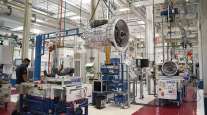Navistar Disputes Rivals’ Claims on Efficiency, Touts ProStar Model as Best in ‘Fluid Economy’
This story appears in the April 16 print edition of Transport Topics.
Officials from truck and engine maker Navistar Inc. have disputed fuel-efficiency claims made by its rivals and said that an independent testing agency has found its over-the-road International ProStar model has better “fluid economy” than three of its rivals.
Navistar defines fluid economy as the combined cost of diesel and diesel exhaust fluid; while its rivals’ engines require DEF, Navistar’s engines don’t.
“We took our most recent competitive models and have conducted new tests by an independent third party that show, once again, that our 2012 ProStar Plus has better fluid economy than any other truck,” Jim Hebe, Navistar’s senior vice president of North American sales operations, said during the Mid-America Trucking Show last month.
While Hebe discussed the tests during the show, the company has not made the full report available.
“The ProStar Plus with MaxxForce 13 had 2.6% better fluid economy than the [Freightliner] Cascadia and 4.6% better than Volvo,” Hebe said.
Hebe said the Kenworth truck had tested so badly that Navistar had it back for additional testing.
Navistar spokesman Steve Schrier told Transport Topics on April 10 that the company worked with the Transportation Research Center on the tests.
Daimler Trucks North America — which makes Freightliner trucks — and Volvo and Mack Trucks, both part of Volvo AB, separately referred to the report as essentially meaningless.
“In our experience, customers do not view fluid efficiency calculations as necessary or useful in the measurement of operating costs for Class 8 trucks,” David Hames, general manager for marketing and strategy at Daimler Trucks North America, told TT. “If a customer wants to look at fuel efficiency, then diesel fuel alone should be considered.”
Navistar upgraded its existing exhaust gas recirculation system to meet 2010 federal standards, but all other manufacturers use selective catalytic reduction technology to meet those standards. SCR requires diesel exhaust fluid (DEF) to help treat nitrogen oxide emissions in the after-treatment system.
“If a customer wants to evaluate total cost of operation (TCO), then we recommend focusing on a true TCO number that includes all fluids and maintenance items such as oil, fuel, DEF and coolant,” Hames said.
“Comparing SCR technology with EGR is like comparing apples to oranges, since EGR so far has not been able to meet the [federal] standard without credits,” Ron Huibers, Volvo Trucks’ president for North American sales and marketing, told TT.
Huibers was referring to the fact that Navistar did not submit an engine to the Environmental Protection Agency for certification until earlier this year, and it is still awaiting an official response.
“The only fluid that counts to our customers is diesel, and it continues to rise,” Huibers said. “At the same time, our EPA 2010 solution delivers excellent fuel economy advantages and the cost of DEF continues to drop.”
Paccar Inc., which owns both Kenworth Truck Co. and Peterbilt Motors Co., did not respond to a request for comment.
Navistar said the test included a Volvo VN 670 with a Volvo D13 engine, the Kenworth T700 with a Cummins ISX 15-liter engine and a Freightliner Cascadia with a DD15.
Schrier said Navistar tested 15-liter models of competitors because, “They tout these models as their fuel economy leaders.”
David McKenna, Mack Trucks’ director of powertrain sales and marketing, said that manufacturers were wrong in projecting SCR operating costs, but on the high side.
“We modeled the DEF dosing rate at 3% of diesel consumed and at a cost of $3.25 per U.S. gallon,” McKenna said. “In actual typical interstate operations, we are dosing DEF on average at 2.2% — 36% lower than modeled. And the DEF cost is actually approximately $2.79 retail, amounting to about another savings of 16%. Both are net gain positives for the customers, so this is a mistake I can live with.”
He said that dosing at 2.2% meant DEF cost “is $0.009 per mile. Not even a whole cent.”
In 2010, Navistar ran similar tests, and claimed that its ProStar Plus topped a Freightliner Cascadia and a Kenworth T660 in fuel economy. The claims were disputed by the rival truck makers.
Navistar’s Schrier said the company has continued to refine the ProStar Plus with the MaxxForce 13 engine since the 2010 tests, further improving the powertrain performance and reducing weight.
“Fluid economy has to take in all of these factors — diesel and DEF costs — but customers also benefit from less weight,” Schrier said. “Lighter weight not only cuts fuel use, but it lets fleets carry heavier loads.”




